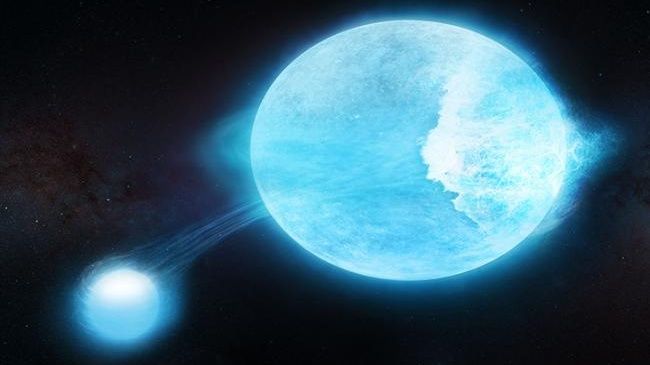Supersonic tsunamis 3 times as tall as our sun are breaking on a distant 'heartbreak star'
By Keith Cooper
published about 18 hours ago
"Each crash of the star's towering tidal waves releases enough energy to disintegrate our entire planet several hundred times over"

An artist's illustration of two glowing blue stars against the dark background of space, one smaller and one larger. They appear to be connected by a wispy trail of stellar material arising from the larger one.
An artist's illustration of the binary star system producing gargantuan stellar waves. (Image credit: Melissa Weiss, CfA)
A massive stellar behemoth is experiencing violent waves three times as tall as our sun crashing down on its surface. Known as a "heartbeat star," the extreme object also periodically pulses in brightness as the gravity of a close companion stretches it into an oblate shape.
In fact, this particular heartbeat star's immense waves are being raised by that unseen companion as it swoops by on a highly elliptical orbit every 32.8 days. Just like how the moon's gravity serves as the primary source of Earth’s tides by pulling our planet's oceans around with it, the gravity of this heartbeat star's companion whips up material from the stellar body, then drags it around at supersonic speeds to form titanic waves.
The binary star system, known as MACHO 80.7443.1718, resides 169,000 light-years from Earth in the Large Magellanic Cloud. It incorporates a giant, 35-solar-mass primary star and a smaller secondary companion. Though first recognized as having variable brightness in 1990, no other stars that pulsed in this fashion were detected until, one day, NASA's Kepler Space Telescope mission spotted a bunch.
Because the shapes of the larger stars in these systems are distorted, they alternately show their wider and narrower sides to us, leading to brightness pulses mimicking a beating heart. That's why scientists aptly named the stellar breed "heartbeat stars" to begin with.
More:
https://www.space.com/supersonic-tsunamis-three-times-tall-sun-heartbreak-star
